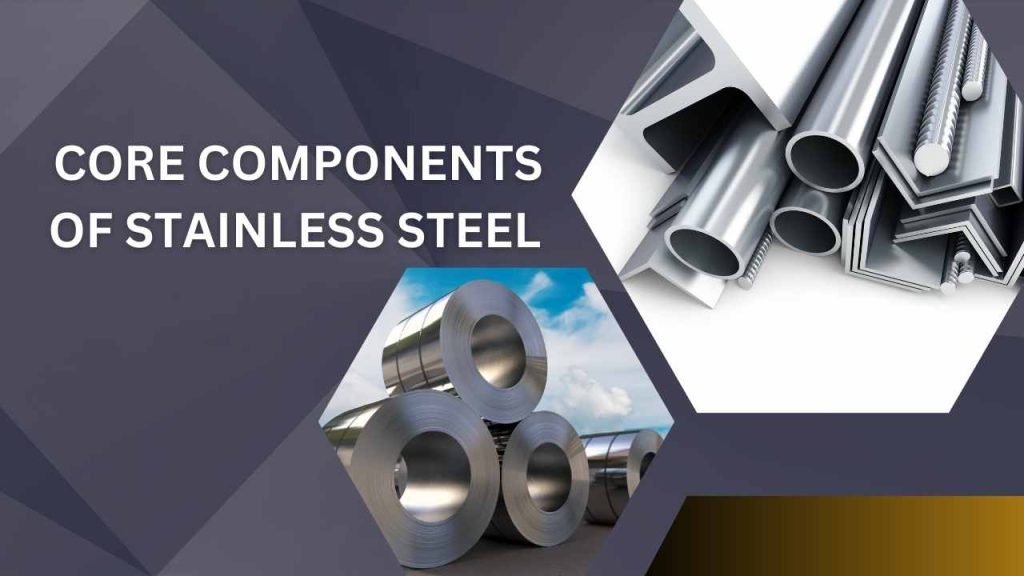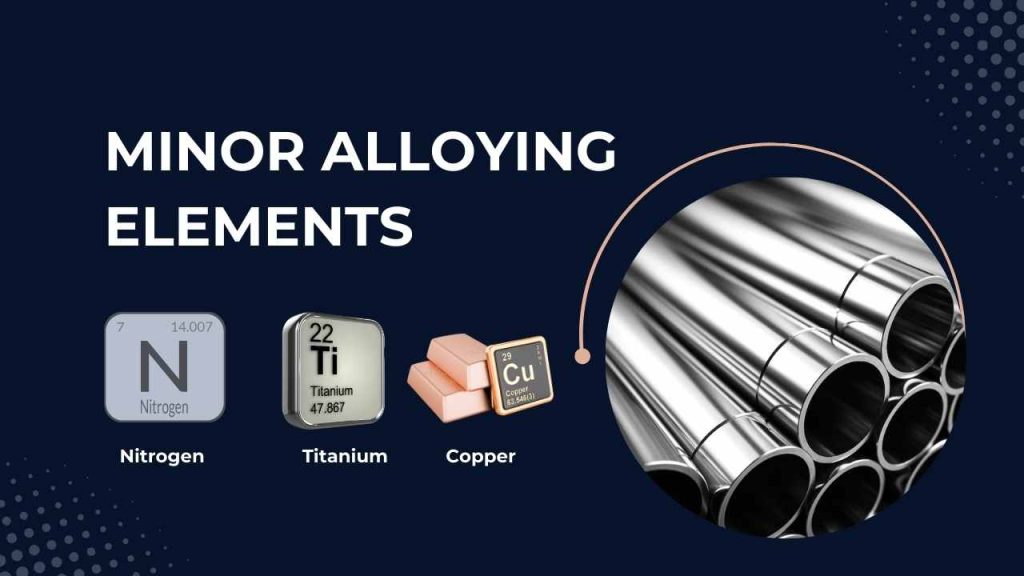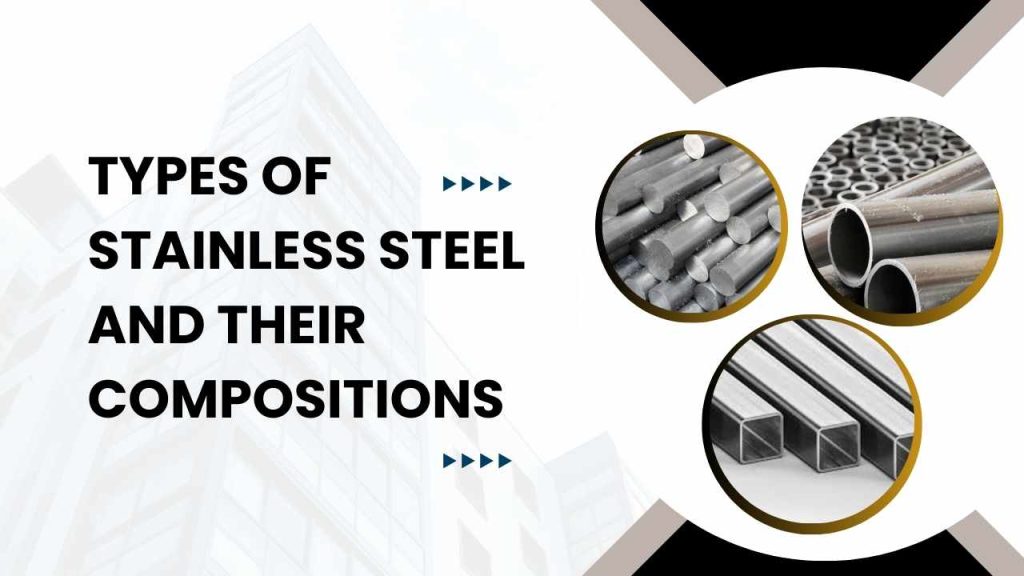What is the composition of stainless steel: Key Elements and Their Functions

Stainless steel is a versatile and durable alloy known for its resistance to corrosion, staining, and rust. This remarkable material combines the strength and workability of steel with the anticorrosive properties of chromium. Combining durability, strength, and aesthetic appeal, stainless steel is used for a wide range of purposes. Its versatility and hygiene properties make it a preferred material in various industries like construction, automotive, medical devices, kitchenware, and more. These specialities of stainless steel are attributable to the elements comprising it.
“What is the composition of stainless steel?”, you might wonder now.
Well, this iron-based alloy comprises various elements including iron, chromium, carbon, nickel, and more. The importance and application of stainless steel spans from everyday items to complex industrial uses, thanks to its versatility and indispensability. Let us explore the importance of the alloy in detail.
- Corrosion Resistance: The ability of stainless steel to resist rust and corrosion extends the lifespan of products and structures reducing maintenance costs and enhancing reliability.
- Hygienic properties: Stainless steel has a non-porous surface that prevents the growth of bacteria and other pathogens. So, it is ideal for applications with high hygienic standards.
- Recyclability: The alloy is 100% recyclable. So, it reduces the environmental impact of production and disposal.
- Strength and durability: Stainless steel’s high tensile strength and durability make it suitable for demanding environments.

The properties of alloy steel make it one of the top raw materials in several industries. Some of its applications include:
- Construction: It is used in building frameworks, bridges, and reinforcements
- Automotive industry: Exhaust systems and decorative parts use stainless steel alloy
- Food and beverage industry: Stainless steel is used in production lines, storage tanks, and kitchen appliances as well as in cutlery and cookware.
- Household goods: Household goods like refrigerators, dishwashers, and washing machines feature stainless steel for its durability and resistance to harsh weather.
- Energy sector: It is also used in the construction of wind turbines and solar panel frames for its durability.
We just explored the benefits and the application of stainless steel. As we proceed we will delve into the complete composition of this alloy, shedding light on the various elements that contribute to its exceptional properties and explaining how these elements impact its performance and sustainability for different applications.
Core Components of Stainless Steel

The exceptional properties of stainless steel always throw one obvious question
“What is the composition of stainless steel?”
Well, let us look into its core components in this segment
- Iron (Fe)
a) Primary base metal
Iron is the fundamental component of stainless steel. It makes up the majority of the alloy’s composition. As the primary base metal, iron provides the necessary strength and structural integrity to the objects created using it. Also, iron’s malleability and ductility allow it to be shaped and framed into various products while maintaining robustness.
b) Role in the overall structure
In the alloy composition of stainless steel, iron serves as the matrix that holds other constituting elements like chromium, nickel, and carbon. Iron’s ability to alloy with these elements enhances the overall properties of stainless steel. It allows for the balance of strength, hardness, and corrosion resistance essential for diverse applications.
- Chromium (Cr)
a) A minimum of 10.5% is required for stainless steel classification
Chromium is crucial for classifying an alloy as stainless steel. A minimum of 10.5% chromium content is required to make stainless steel corrosion resistant. It is important to add chromium in this specific amount to ensure that the alloy can form a protective oxide layer that prevents rust and degradation.
b) Contribution to corrosion resistance
Chromium reacts with oxygen to form a thin, invisible layer of chromium oxide on the surface of steel. The pervasive layer acts as a barrier, preventing further oxidation and corrosion. Even if you stretch the surface the oxide layer can self-heal. This feature is important for maintaining the alloy’s protective properties.
Alloying Elements and Their Functions
While discussing what is in the composition of stainless steel one must not miss out on Nickel, Molybdenum, Carbon, Manganese, and Silicon. All these elements add some special properties to stainless steel that make it exceptional and valuable to numerous industries.
- Nickel (Ni)
a) Enhances corrosion resistance
Nickel improves the overall corrosion resistance of stainless steel, making it perfect to be used in acidic conditions. It helps maintain the integrity of the protective chromium oxide layer in aggressive environments.
b) Improves formability and weldability
Nickel stabilizes the austenitic structure of stainless steel, making it more ductile and easier to form. That is not all, it also enhances weldability by preventing the formation of brittle phases during the welding process, ensuring strong and durable joints.
- Molybdenum (Mo)
a) Increases strength and toughness
Molybdenum enhances the mechanical properties of stainless steel, including its strength and toughness. It contributes to higher resistance against wear and deformation, making the alloy suitable for relevant applications.
b) Further enhances resistance to pitting corrosion
Molybdenum is used to improve the alloy’s resistance to pitting and crevice corrosion, especially in environments that have chloride, like seawater. This property of stainless steel makes it ideal for marine and chemical processing applications.

- Carbon (C)
a) Effects on hardness and strength
Carbon is an important component in the alloy composition of stainless steel. It increases the hardness and strength of the alloy. The higher the carbon content the more the formation of carides. Carbides are crucial for enhancing stainless steel’s wear resistance and hardness.
b) Balancing act with chromium to prevent corrosion
In the previous paragraph, we mentioned that the formation of carbides increases with the carbon content. So, it is important to balance the amount of carbon added to the alloy. Excessive amounts of carbides can deplete the chromium available for the formation of the protective oxide layer. The right amount of carbon can maintain the strength of the alloy along with its corrosion resistance.
- Manganese (Mn)
a) Improves tensile strength and toughness
A blog exploring what is in the composition of stainless steel is incomplete without mentioning Manganese. If you have seen materials made of stainless steel then you must have noticed its toughness. Manganese is the contributor to the strength and toughness of stainless steel. This element improves the alloy steel’s ability to withstand stress without breaking.
b) Aids in deoxidizing steel during production
Manganese is indispensable for creating strong stainless steel. It acts as a deoxidizer during the steel-making process. It removes oxygen and prevents the formation of harmful oxides. These oxides in turn are capable of weakening the steel and limiting its applications.
- Silicon (Si)
a) Improves strength and hardness
Silicon is important for improving the strength and hardness of stainless steel. It contributes to the overall structural integrity of the alloy making it more resilient to mechanical stress.
b) Acts as a deoxidizing agent
Just like Manganese, Silicon also serves as a deoxidizer. It is used for removing oxygen from the molten steel and improving its quality by preventing the formation of gas pockets and inclusions.
It’s very important to clean stainless steel; it gives you good looks and services also best.
Minor Alloying Elements

In the previous segment, we discussed the chief elements in the composition of stainless steel. Here we will look into the minor alloying elements which although used in small quantities are highly crucial for creating the alloy.
- Nitrogen (N)
a) Enhances tensile strength
While considering what is in the composition of stainless steel, the role of Nitrogen must not be overlooked. Nitrogen increases the tensile strength of stainless steel, makes it more resistant to deformation and enhances its mechanical performance.
b) Improves pitting resistance
Nitrogen also contributes to improved pitting resistance, especially in duplex and austenitic stainless steel. It helps the alloy withstand localized corrosion in aggressive environments.
- Titanium (Ti)
a) Prevents grain boundary chromium carbide precipitation
We have previously mentioned that the addition of carbon to stainless steel leads to the formation of carbides. An excessive formation can deplete the chromium in the alloy. This is where Titanium comes in handy. It prevents the formation of chromium carbides at grain boundaries. This stabilization helps in the creation of corrosion-resistant stainless steel.
b) Stabilizes the structure at high temperatures
Titanium enhances the alloy’s performance at high temperatures by maintaining its structural integrity and preventing embrittlement.
- Copper (Cu)
a) Adds to corrosion resistance
Copper enhances the overall corrosion resistance of stainless steel. It is especially required in environments where sulphuric acid is present. Moreover, copper helps prevent surface tarnishing and improves the longevity of the material.
b) Benefits in specific environments like seawater
As we mentioned earlier, the use of copper in stainless steel alloy makes the latter suitable for various environments. Copper’s corrosion resistance properties make it highly beneficial in marine applications where exposure to saltwater can lead to rapid degradation of other materials.
Types of Stainless Steel and Their Compositions

In the previous segment, we covered what is in the composition of stainless steel. Here we will be exploring the different types of stainless steel along with their specific composition.
- Austenitic Stainless Steel
Austenitic stainless steel is a type of stainless steel known for its excellent corrosion resistance and non-magnetic properties.
a) The high nickel and chromium content
This type of steel is characterized by its high chromium (usually 16 -26% ) and nickel (6- 22%) content. This combination gives it excellent corrosion resistance and the ability to maintain the structure across a wide range of temperatures.
b) Non-magnetic and excellent corrosion resistance
This type of stainless steel is non-magnetic due to its face-centered cubic crystal structure. It offers superior corrosion resistance. This in turn makes the alloy ideal for applications in harsh environments such as chemical processing, food and beverage equipment, and medical devices.
- Ferritic Stainless Steel
a) Higher chromium content, low carbon
Ferritic stainless steel is a corrosion-resistant steel. It contains a higher chromium content (almost 10.5 to 30%) and a comparatively lower content of carbon (almost less than 0.1%). This composition enhances their corrosion resistance, especially around stress corrosion cracking.
b) Magnetic, good corrosion resistance but lower ductility
Ferritic stainless steels have a body-centered cubic crystal structure making them magnetic. Although they have a lower ductility as compared to austenitic stainless steel, they offer good corrosion resistance, especially to chloride-induced stress corrosion cracking. Some of its common applications include automotive exhaust systems, industrial equipment, and architectural structures.
- Martensitic Stainless Steel
Martensitic stainless steel is a type of stainless steel that is popular for its strength, hardness, and moderate corrosion resistance. Unlike austenitic and ferritic steel, you can harden this steel through heat treatment.
a) Higher carbon content
This blog answers the question- “what is the composition of stainless steel?”
So far we have seen that different types of stainless steel vary their properties due to the variation in the quantity of elements added. Martensitic stainless steels are no different. They have a higher carbon composition (0.1 – 1.2%), which contributes to their hardness and strength. The chromium content typically ranges from 11.5 to 18%.
b) Magnetic, high strength but lower corrosion resistance
Having a body-centered tetragonal crystal structure, martensitic stainless steels offer high strength and hardness making them suitable for applications that require wear and resistance, such as cutlery, surgical instruments, and industrial blades. However, they have lower corrosion resistance compared to the other grades of stainless steel.
Conclusion
Most of us are aware of stainless steel or alloy steel. Rich in multiple properties this is indispensable for many industries from a wide range of sectors. The utility of stainless steel is attributable to its components. In this blog we tried to decode what is in the composition of stainless steel. Not only did we look into these elements and their properties but we also tried to understand how they contribute to the alloy’s features. If you are someone who is considering researching stainless steel, then this blog is all you need. We have Fabrication of steel, where you can make your product Strong
FAQs:
1.Where can I buy steel for construction in Mangalore?
You can get in touch with Acier Roof Solutions, one of the leading dealers of steel roofing sheets and good quality steel.
2. What is the average cost of stainless steel?
Stainless steel sheets with less than 5 mm thickness are around Rs 600/ kilogram.
3. Is stainless steel environmentally friendly?
Stainless steel is 100% recyclable, and it is durable. It is highly durable, so the products made from it often have longer lifespans, thus reducing the need for frequent replacements.
4. What factors determine the grade of stainless steel?
The grades of stainless steel are determined by its chemical composition, especially the amount of chromium, nickel, and other alloying elements
5. Can stainless steel be magnetic?
Yes, certain types of stainless steel can be magnetic. For example, ferritic and martensitic stainless steels are magnetic.
